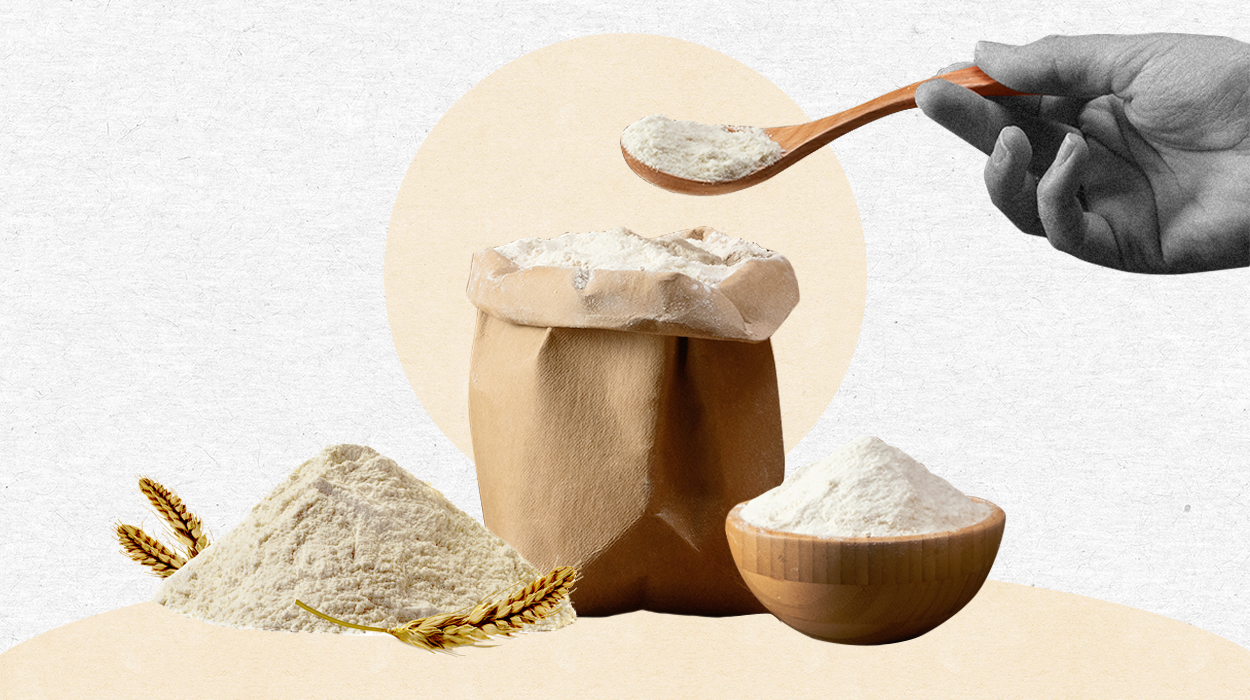 Evidence Based
Evidence Based
Evidence Based
This article is objectively based on relevant scientific literature, written by experienced medical writers, and fact-checked by a team of degreed medical experts.
Our team of registered dietitian nutritionists and licensed medical professionals seek to remain objective and unbiased while preserving the integrity of any scientific debate.
The articles contain evidence-based references from approved scientific sites. The numbers* in parentheses (*1,2,3) will take you to clickable links to our reputable sources.
Is Flour Vegan? What The Research Says In 2024

When you see a vegan pastry, cake, or loaf of bread, you may wonder: “Is flour vegan?” The answer is yes! Flour is usually made from grains and thus is vegan. Non-vegan food comes from animals,[1] and vegan food comes from plants.
If you are on a vegan diet, you don’t have to worry about flour. But you do have to worry about other ingredients in baked goods like eggs, milk, and butter. Read on to learn about the different types of vegan flour.
Can Flour Be Eaten On A Vegan Diet?
Yes, flour is vegan and can be eaten on a vegan diet. Flours are typically made from plant-based foods, such as grains, nuts, and seeds. Plant-based products are vegan because they are not derived from animals.
Can Vegans Eat Flour?
Yes, vegans can eat flour. If flour shows up in your vegan meal kit, there is no need to worry! Flour is made by grinding grains or other plant-based ingredients into a powder. Since most flour is derived from plants, not animals, it is vegan.
Flour Additives
All flour should be vegan unless it has added non-vegan ingredients. If you are following a vegan diet, always look at the ingredients of your products.
The ingredients in flour are usually minimal, encompassing the grain, preservatives, rising agents, and any vitamins added.
One potential but rare non-vegan additive is L-cysteine,[2] which might be added to flour to increase elasticity for baking. L-cysteine, which also might be listed as E920, is an amino acid that might be derived from animals.
Flour Blends And Cake Mixes
Some flour mixes advertised as high-protein flours may include a whey-based protein additive. Whey protein powder[3] derives from cow’s milk and is not vegan. Cricket flour[4] is another high-protein flour additive to watch out for. Since crickets are insects, cricket flour is not vegan.
Similarly, some baked goods mixes like cake, brownie, and cookie mixes may include powdered animal-based products. Always check the ingredients and allergen list for animal-based products.
What Is Flour?
Flour is in so many products, from baked goods to meal replacement bars to sauces.
Flour is a fine powder made from dried and ground-up grains – usually wheat, rye, corn, or rice.[5] Specialist flours, such as gluten-free flour,[6] might also be made out of nuts,[7] seeds, or starchy vegetables.[8]
Wheat Flour
Regular flour is made from wheat. It comes in several forms, including all-purpose flour, cake flour, bread flour, self-rising flour, and whole wheat flour. All of these flours are cultivated and processed differently[9] to produce specific properties for various applications. They each have distinct chemical compositions with different amounts[10] of fiber and gluten.
Gluten-Free Flour
Corn flour,[11] also known as maize flour, is another type of flour that is popular in Latin American cuisine. Corn flour is typically used to make tortillas and tamales. Rice flour is often used in Asian cuisine or as a gluten-free alternative to regular wheat flour. For example, rice noodles are made from rice flour.
Many other grains can be made into flour, including oats, buckwheat, quinoa, amaranth, and sorghum. These flours are all gluten-free and whole grain, meaning they are higher in fiber and protein[12] than regular white flour. On the other hand, corn and rice flour are usually refined, and nutrients are lost[11] during processing.
Gluten-free flour blends designed for baking usually incorporate several ingredients to achieve the desired properties. However, gluten-free flour mixes tend to be lower in protein and fiber[5] than their whole-grain flour alternatives.
Non-Grain Flour
Other foods[5] like legumes, nuts, seeds, coconut, and even fruits can be made into flour. For example, almond flour, garbanzo flour, and coconut flour are popular gluten-free flour alternatives not made from grains.
Flour Production
The production of flour can be split up into four steps: growing the crop, milling, grinding, and treatments such as fortification. The exact processes used to make flour are constantly evolving[13] as researchers try to make the process more sustainable, economically efficient, and environmentally friendly.
Growing The Crop
Varieties of grain crops are bred to have different properties.
For example, wheat varieties are defined as hard or soft.[12] Soft wheat has a lower gluten content and higher starch content than hard wheat. As such, hard and soft wheat varieties are used for different applications.
Hard wheat typically becomes bread flour, and soft wheat becomes cake flour. All-purpose flour may be made from a mix of hard and soft flour or from a wheat cultivar with medium gluten concentration levels.
Milling
Whole grains have three parts: the bran, the germ, and the endosperm. Refined flours[14] go through a milling process, which removes the bran and germ.
Milling improves the texture of the flour but removes much of the iron, dietary fiber, and B vitamins[12] from wheat flour. Whole-grain flour does not go through the milling process, so it has all three parts of the grain intact.
Grinding
For refined flour, the grain – now reduced to the endosperm – is ground into a fine powder. The same happens for whole-grain flour, but the entire grain is ground together.
Fortification
Refined flours should be enriched to restore some of the nutrients lost during milling.[14] This is mandatory in many countries.[15] In the USA,[16] refined wheat flour is fortified with calcium, iron, and B vitamins. Enriched foods such as fortified flour[17] and greens powders can be a good source of vitamins and minerals.
Other Treatments
Sometimes soft white flour is bleached with substances such as chlorine.[18] Bleaching flour alters the way that the flour absorbs water and reduces the elasticity of the gluten proteins. This improves the dough functionality[19] for some applications, such as baking cakes, but not for bread due to the reduced gluten elasticity.
Researchers believe that chlorine treatments may have negative health impacts[20] and are looking for alternative methods for treating flour. Ozone treatment[21] is an alternative to chlorine to improve the texture and shelf-life of flour.
If you want to avoid chlorine-treated flour, look for flours labeled as unbleached. However, unbleached flour might alter the texture of your cake. Bleached flour makes a cake with a lighter crumb than unbleached flour.
Variety Of Vegan Flour
Since there are so many vegan flours, you may wonder which flour you should use. The best flour for you will depend on what you are using it for and any health concerns you may have.
Gluten-Free Flours
If you are also gluten-free, you must avoid all wheat, rye, and barley flours. All-purpose gluten-free flours tend to be made from a blend of ingredients like chickpea flour, sorghum flour, and rice flour. Since no one alternative flour is a perfect replacement for wheat flour, gluten-free blends usually work best.
Whole Grain Flours
If you are trying to maintain a healthy diet, you may want to incorporate whole grains into your diet. Whole grain flours have many health benefits[12] over traditional refined flours.
The USDA recommends[14] that at least half of the grains in your diet are whole grains. Eating whole grains aids digestion, may reduce the risk of developing heart disease, and can help you maintain a healthy weight.
White wheat flour is typically used over whole wheat flour in baked goods because it results in a superior crumb structure. Most people prefer the texture[12] of baked goods made with white flour. That being said, you can replace part of your white flour with whole wheat flour with minimal texture changes.
It is always best to find a recipe that uses whole wheat flour rather than trying to replace white flour. Since the structure of these flours is different, recipes developed specifically for whole wheat flour tend to perform better.
Many alternative flours like oat flour, quinoa flour, brown rice flour, sorghum flour, buckwheat flour, millet flour, and amaranth flour are alternative whole grain flours.
Summary
Nearly all types of flour are derived from plants and are thus vegan. If you are concerned that a type of flour is not vegan, look at the ingredients and see if any animal-based ingredients have been added.
If possible, choose whole-grain flour or fortified flour over white, refined flour. The former tend to provide more nutrients, especially protein, fiber, iron, and B vitamins. It’s recommended to consume at least half grains and grain products as whole grains.
Frequently Asked Questions
Flour is vegan! Flour is typically made from wheat or other grains, which are plants. Other popular flours like corn flour, rice flour, and almond flour all come from plants and as such are vegan.
Regular flour refers to flour made from wheat. Wheat flour is vegan because it derives from plants and not animals.
Nearly all flours are plant-based because they come from plant-based ingredients like wheat, oats, or almonds. Sometimes flour mixes that are advertised as high-protein alternatives to regular flour contain whey and are not vegan.
+ 21 sources
Health Canal avoids using tertiary references. We have strict sourcing guidelines and rely on peer-reviewed studies, academic researches from medical associations and institutions. To ensure the accuracy of articles in Health Canal, you can read more about the editorial process here
- Sakkas, H., Petros Bozidis, Christos Touzios, D. Kolios, Athanasiou, G.N., Eirini Athanasopoulou, Gerou, I. and Constantina Gartzonika (2020). Nutritional Status and the Influence of the Vegan Diet on the Gut Microbiota and Human Health. [online] 56(2), pp.88–88. doi:https://doi.org/10.3390/medicina56020088.
- PubChem (2023). Cysteine. [online] @pubchem. Available at: https://pubchem.ncbi.nlm.nih.gov/compound/Cysteine.
- Ozel, B., David Julian McClements, Cagatay Arikan, Kaner, O. and Mecit Halil Oztop (2022). Challenges in dried whey powder production: Quality problems. [online] 160, pp.111682–111682. doi:https://doi.org/10.1016/j.foodres.2022.111682.
- Bartkiene, E., Vytaute Starkute, Konstantinas Katuskevicius, Neringa Laukyte, Markas Fomkinas, Ernestas Vyšniauskas, Kasciukaityte, P., Emilis Radvilavicius, Skaiste Rokaite, Domantas Medonas, Emilija Valantinaviciute, Mockus, E. and Egle Zokaityte (2022). The contribution of edible cricket flour to quality parameters and sensory characteristics of wheat bread. [online] 10(12), pp.4319–4330. doi:https://doi.org/10.1002/fsn3.3024.
- Hughes, J., Vaiciurgis, V. and Grafenauer, S. (2020). Flour for Home Baking: A Cross-Sectional Analysis of Supermarket Products Emphasising the Whole Grain Opportunity. [online] 12(7), pp.2058–2058. doi:https://doi.org/10.3390/nu12072058.
- Dalia El Khoury, Balfour-Ducharme, S. and Joye, I.J. (2018). A Review on the Gluten-Free Diet: Technological and Nutritional Challenges. [online] 10(10), pp.1410–1410. doi:https://doi.org/10.3390/nu10101410.
- Martins, R., Gouvinhas, I., Maria Tereza Nunes, Peres, J.A., Raymundo, A. and Barros, A.P. (2020). Acorn Flour as a Source of Bioactive Compounds in Gluten-Free Bread. [online] 25(16), pp.3568–3568. doi:https://doi.org/10.3390/molecules25163568.
- Dulcineia, B., Karina Teixeira Magalhães-Guedes, Lemos, P.C., Leonardo Fonseca Maciel, Disney Ribeiro Dias, Janice Izabel Druzian and Rosane Freitas Schwan (2020). Development of arrowroot flour fermented by kefir grains. [online] 85(11), pp.3722–3730. doi:https://doi.org/10.1111/1750-3841.15472.
- Gómez, M., Luiz Carlos Gutkoski and Ángela Bravo-Núñez (2020). Understanding whole‐wheat flour and its effect in breads: A review. [online] 19(6), pp.3241–3265. doi:https://doi.org/10.1111/1541-4337.12625.
- Henrique, J., de, L., Cristianini, M. and Caroline Joy Steel (2021). Non-thermal emerging technologies as alternatives to chemical additives to improve the quality of wheat flour for breadmaking: a review. [online] pp.1–17. doi:https://doi.org/10.1080/10408398.2021.1966380.
- Gwirtz, J.A. and María Nieves García-Casal (2013). Processing maize flour and corn meal food products. [online] 1312(1), pp.66–75. doi:https://doi.org/10.1111/nyas.12299.
- Candela Paesani, Moiraghi, M., Sciarini, L.S. and Pérez, G.T. (2020). Whole-flours from hard and soft wheat genotypes: study of the ability of prediction test to estimate whole flour end-use. [online] 58(4), pp.1462–1469. doi:https://doi.org/10.1007/s13197-020-04658-1.
- Cappelli, A. and Cini, E. (2021). Challenges and Opportunities in Wheat Flour, Pasta, Bread, and Bakery Product Production Chains: A Systematic Review of Innovations and Improvement Strategies to Increase Sustainability, Productivity, and Product Quality. [online] 13(5), pp.2608–2608. doi:https://doi.org/10.3390/su13052608.
- www.myplate.gov. (n.d.). Grains | MyPlate. [online] Available at: https://www.myplate.gov/eat-healthy/grains.
- Marks, K.J., Luthringer, C.L., Ruth, L.J., Rowe, L., Khan, N.M., Luz Maria De-Regil, Ximena López and Pachón, H. (2018). Review of Grain Fortification Legislation, Standards, and Monitoring Documents. [online] 6(2), pp.356–371. doi:https://doi.org/10.9745/ghsp-d-17-00427.
- United States Department of Agriculture. (2016). All Purpose Wheat Flour/Bread Flour (WFBF7) For Use In International Food Assistance Programs. [online] Available at: https://www.ams.usda.gov/sites/default/files/media/wfbf7.pdf.
- Rossana, Fernandes, Â., González-Paramás, A.M., Barros, L. and Isabel C.F.R. Ferreira (2019). Flour fortification for nutritional and health improvement: A review. [online] 125, pp.108576–108576. doi:https://doi.org/10.1016/j.foodres.2019.108576.
- Bosmans, G., Laurens Peene, Ingrid Van Haesendonck, Kristof Brijs and Delcour, J.A. (2019). Impact of chlorine treatment on properties of wheat flour and its components in the presence of sucrose. [online] 274, pp.434–443. doi:https://doi.org/10.1016/j.foodchem.2018.09.019.
- Yasui, A., Oishi, M., Hayafuji, C., Kobayashi, C., Shindo, T., Ozawa, H. and Nakazato, M. (2016). Analysis of Azodicarbonamide in Wheat Flour and Prepared Flour Mixes. [online] 57(5), pp.133–138. doi:https://doi.org/10.3358/shokueishi.57.133.
- Al-Dmoor, H. and El-Qudah, J. (2016). Cake Flour Chlorination and Alternative Treatments (Review). Current Research in Nutrition and Food Science Journal, 4(2), pp.127–134. doi:https://doi.org/10.12944/crnfsj.4.2.06.
- Obadi, M., Zhu, K.-X., Peng, W., Sulieman, A.A., Amer Ali Mahdi, Mohammed, K.D. and Zhou, H.-M. (2017). Shelf life characteristics of bread produced from ozonated wheat flour. [online] 49(5), pp.492–502. doi:https://doi.org/10.1111/jtxs.12309.



